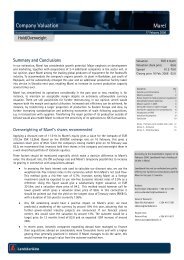Ársskýrsla Landsbankans - Landsbankinn
Ársskýrsla Landsbankans - Landsbankinn
Ársskýrsla Landsbankans - Landsbankinn
You also want an ePaper? Increase the reach of your titles
YUMPU automatically turns print PDFs into web optimized ePapers that Google loves.
Notes to the Consolidated Financial Statements<br />
3. Significant accounting policies (continued)<br />
Property and equipment<br />
All property and equipment is recognised at cost, less accumulated depreciation and accumulated impairment losses. The cost includes expenditures<br />
directly attributable to acquiring these assets.<br />
Subsequent costs are included in an asset’s carrying amount only if it is probable that future economic benefits associated with the item will flow to<br />
the Group and if these costs can be reliably measured. All other repairs and maintenance are charged to the income statement of the financial period<br />
in which their costs are incurred.<br />
Depreciation of any property and equipment is calculated using the straight-line method. This method is applied to the depreciable amount of the<br />
assets, which is their cost less their residual value over their estimated useful lives, as follows:<br />
Buildings 25-50 years<br />
Computer hardware 3 years<br />
Other equipment and motor vehicles<br />
3-10 years<br />
The assets' residual values and useful lives are reviewed annually and adjusted where appropriate.<br />
Gains and losses on disposals are determined by comparing the sale price of an asset with its carrying amount on the date of sale. Gains and losses<br />
are included in the item "Other income and expenses" in the consolidated income statement.<br />
Intangible assets<br />
(a) Computer software licenses<br />
Acquired computer software licenses are capitalised on the basis of the costs incurred to acquire and bring them into service. Computer software<br />
licenses recognised as intangible assets are amortised over their useful life, which is estimated to be 3 - 5 years.<br />
The costs associated with maintaining computer software are recorded as expenses at the time they are incurred.<br />
(b) Goodwill<br />
Goodwill is recognised as an asset only if acquired in a business combination. It is recognised as of the acquisition date and measured as the<br />
aggregate of (a) the fair value of the consideration transferred, (b) the recognised amount of any non-controlling interest in the acquiree, and (c) the<br />
fair value of any previously held equity interest in the acquiree, less the net recognised amount (generally fair value) of the identifiable assets<br />
acquired and liabilities assumed, all measured as of the acquisition date. The consideration transferred includes the fair value of assets transferred,<br />
liabilities incurred and equity interests issued by the Group. In addition, consideration transferred includes the fair value of any contingent<br />
consideration.<br />
Following initial recognition, goodwill is measured at cost, less any accumulated impairment losses. Goodwill is generally reviewed for impairment<br />
annually, but more frequently if events or changes in circumstances indicate a potential impairment of the carrying amount. For the purpose of<br />
impairment testing, goodwill is allocated as of the acquisition date to each of the Group’s cash-generating units (CGUs) or group of CGUs which are<br />
expected to benefit from the synergies of the combination, irrespective of whether other assets or liabilities of the acquiree are assigned to those<br />
units. Each unit to which this goodwill is allocated represents the lowest level within the Group at which the goodwill is monitored for internal<br />
management purposes. Where goodwill is attached to a particular unit of a CGU (or of a group of CGUs) and part of the operations within that unit is<br />
disposed of, the goodwill that is associated with the operations disposed of is included in the carrying amount of these operations when determining<br />
the gain or loss incurred upon disposing of the operations.<br />
Impairment of non-financial assets<br />
Assets with an indefinite useful life are not subject to amortisation but are tested annually for impairment. Assets that are subject to amortisation<br />
are reviewed for impairment whenever events or changes in circumstances indicate that the carrying amount may not be recoverable. An impairment<br />
loss is recognised for the amount by which the asset’s carrying amount exceeds its recoverable amount. The recoverable amount is either an asset’s<br />
fair value less selling costs or its value in use, whichever is higher. For the purposes of assessing impairment, assets are grouped at the lowest levels<br />
for which there are separately identifiable cash flows (cash-generating units). With the exception of goodwill, non-financial assets are reviewed at<br />
each reporting date for any possible reversal of impairment.<br />
NBI hf. Consolidated Financial Statements 2010 17<br />
All amounts are in ISK million<br />
Allar upphæðir eru í milljónum króna Ársreikningur 2010 117



